In volleyball there are a few different options when it comes to what formations you can use to give yourself the tactical edge over the opposition.
When I say a few formations I actually mean 3 formations.
Table of Contents
The 3 Formations In Volleyball
The 3 formations in Volleyball are as follows:
The number in each of the noted formations represent the number of hitters and the number of setters on court at anyone time.
Using the 6-2 formation as an example, the 6 represents the number of hitters and the 2 represents the number of setters.
Now I know what your thinking.
‘But wait a Volleyball team has 6 players not 8?’
Yes you are absolutely correct.
The 6-2 formation doesn’t actually have 8 players on court but it does mean that all 6 players are hitters and 2 of those 6 players are setters.
Now this may seem confusing and complicated at the moment but I assure you by the end of this article it will all make sense.
In this article I am hoping to teach you; exactly what the 6-2 formation is, advantages of using the 6-2 formation, disadvantages of using the 6-2 formation and lastly exactly how and when to rotate in this formation.

What Is The 6-2 Volleyball Formation
The 6-2 Volleyball formation is a formation that is more commonly at more advanced levels.
As mentioned above the 6 & 2 in this formation represent the number of setters and hitters on court at any one time.
So in this case the 6 represents the number of hitters whereas the 2 represents the number of setters.
Now I know these numbers are a tad confusing as unlike both the other two formations, these being the 5-1 and 4-2, the 6-2 doesn’t equal the correct number of players.
This formation is very much an advanced or progressed version of the 4-2 volleyball formation.
The main difference between the two is that unlike in the 4-2, the setter in the back is the primary setter.
The main purpose of this is to ensure there are always 3 good blockers and 3 good hitters available in the front row.
What this means in practice is that if you have a player who is particularly good setter but maybe isn’t a great jumper and therefore would be a weakness in the front row, when it comes time for this setter to move to the front row, they could be switched out for a better blocker/ attacker.
Advantages Of The 6-2 Volleyball Formation
Has Three Hitters/ Blockers In The Front Row
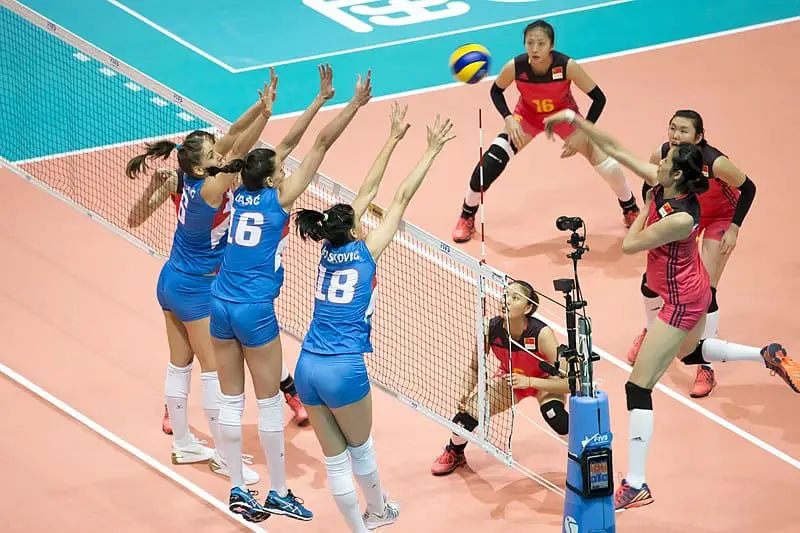
So I kind of already touched on this one above, but one of the main advantages to running the 6-2 is the fact that you can have 3 strong blockers and 3 strong attackers in the front line at all times.
This is a fantastic way to give yourself an advantage over the opposition as it means the blockers on the other team will have a hard time deciding where the set is going to go.
Couple this with a particularly deceptive setter and can guarantee lots of 1v1 situations and as we know a 1v1 situation almost always ends in a point to the attacking side.
Provides Flexibility In Line-up
So again I struggled to keep this one a secret for long enough and I have already touched on it above.
However, one of the other main benefits to using this formation is it allows a team to swap out players that may be a liability in the front row for stronger blockers and hitters.
In most cases the player that is swapped out is normally the setter who is moving front row.
I think it is fair to say that in most cases the setter is someone who is very good at running an offense but isn’t necessarily the strongest blocker or setter.
By using two setters in this formation and the main setter being the one in the back court, it can often be a great tactical advantage to swap the setter out and bring out a stronger front row player.
Disadvantages Of The 6-2 Volleyball Formation.
As with all things there are always disadvantages to an otherwise perfect tactic.
Difficult For Setters To Begin With
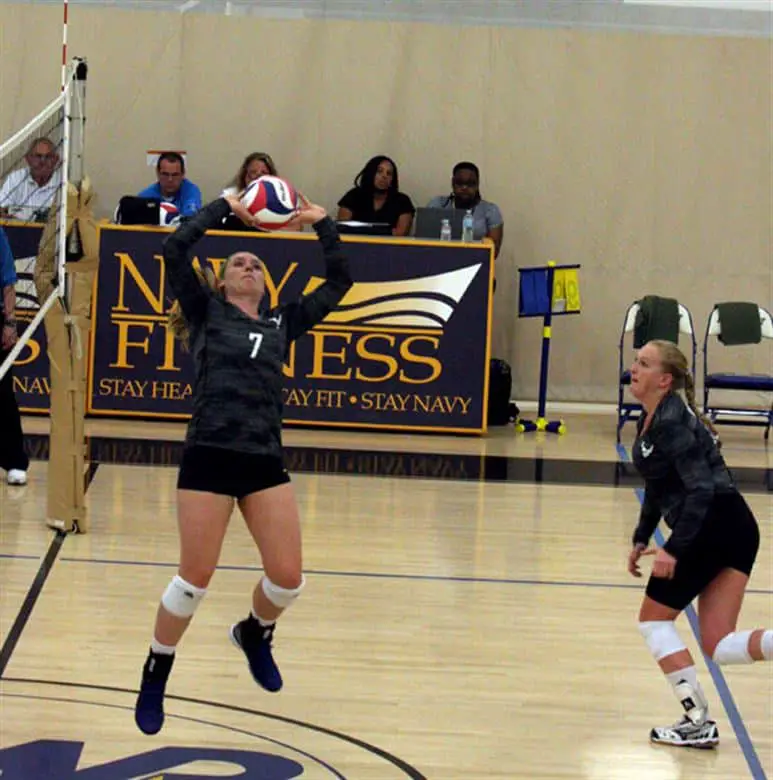
So I will be honest, I don’t know if this is a general disadvantage or just a problem that I always struggled with when my team adopted the 6-2 formation.
I became a setter to be involved in every play and I have always enjoyed the ability to run the offense.
Now my team doesn’t run this formation often which may explain why I struggled so much when we first started playing it.
However, as a setter it can get really difficult to not take that second ball and instead be ready to hit, especially when all you have done for the last few years is take and set every second ball.
So speaking from experience this rotation can be a tricky one for setters to adjust to, that is providing the setter when moving front court isn’t swapped out for a different player.
Confusing Concepts For New Players
So this kind of touches on the above point however I want to talk more about how this affects the whole team rather than just the setters.
When you are new to the game of volleyball you are almost instantly taught that the setter is a player who sets from the front court in position 2/2.5.
So when you suddenly have a player running forward from the back row to take every set it can leave new people confused.
On top of that with players potentially swapping in and out all the time as defensive players are replaced by front row players.
The whole concept of this formation really turns things on its head.
Can Affect Team Cohesion With Lineup Changes
Staying true to the players swapping in and out all the time I want to touch on how this formation can affect team cohesion.
I feel this is particularly true when it comes to setters.
The key to a good offense is a good relationship and understanding between the setter and hitters.
For example when trying to run a quick middle attack, if the setter is perfectly in tune with the middle hitter it is going to be almost impossible to run a consistent effective middle hit.
As mentioned the most common player swapped out is the setter, constantly rotating in setters reduces the time the hitters have to build a report and relationship with the setter, it also reduces the number of reputations the setter has.
This would obviously greatly affect the teams cohesion, this is just one example of how switching in and out players can take a toll on a team.
Can Leave Holes In The Defense
This formation can be risky because it can lead to some confusion or even leave holes in the defense.
An example would be if the back row setter is creeping forward ready to set, this could easily leave a hole for the opposition to exploit at the 1 position (Back Right Corner)
Now having a disciplined player who prioritizes defense over setting would easily solve this problem, however this leaves a different issue as now the team is out of system and the second setter or another player must take the set.
Alternatively if the opposition have to give a free ball the 2 player could swap with the setter as the free ball comes over the net to take the first ball and free up the setter.
How To Rotate When Serving In The 6-2 Volleyball Formation
So before we dive into these rotations it is important to underside what position every player is currently standing in to ensure we fully understand where players start and where the end up after each rotation.
This is probably one of the only rotations where there isn’t really any reason to have a specific person start the team off serving.
A common starting lineup that I have played when using this formation is as follows.
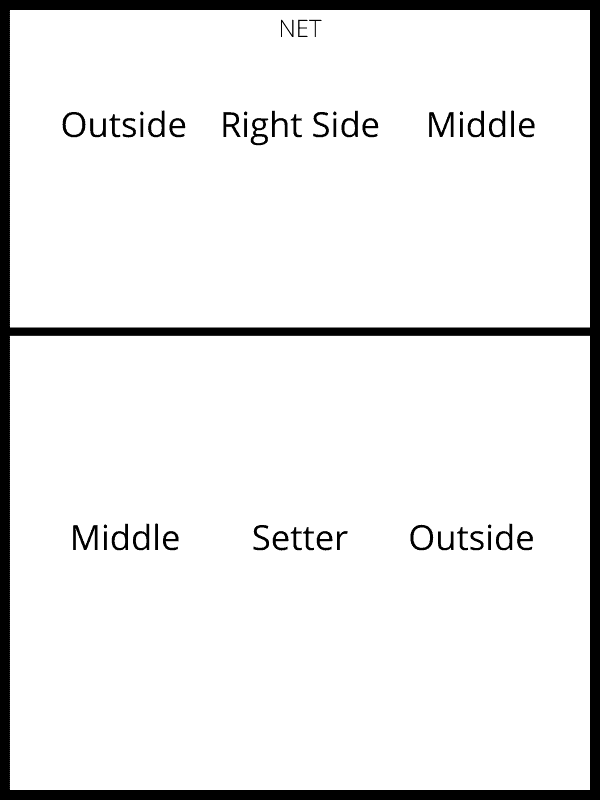
So as you can see from the above this would put the outside player as the first server.
With the outside starting us of serving this means the other outside player is already in the ideal position opposite them at position 4.
Next to the outside serving is the setter who is the primary setter as they are back court. Opposite the back court setter you would have the 2nd setter could act as a right sided hitter or being replaced by an opposite.
Next to the setter in the back row we have the middle who is standing in their perfect base position for defense already.
Opposite the backcourt middle is the front court middle.
Before we start dissecting these rotations I feel it is worth pointing out that in these rotations I have the middle player who is back row, play in position 5 (Bottom left) and the outside play in position 6.
You may see these two players the other way round from time to time.
Ultimately there is an argument to play them either way round so the final call should go to your coach however I personally like to have the outside at position 6 so they can be ready for the back row pipe attack.
6-2 Volleyball – Serve Rotation 1
So in rotation as mentioned above we have the outside starting us off serving.
As the outside is off the court they aren’t taken into account when it comes to the rules of rotating/ positioning.
Based on this our setter who ideally wants to move round to position 1 (Bottom right) can actually start off standing there without worrying about crossing to the right of the outside.
This means our outside once they have served can step straight on court at the deep 6 position.
In the front row you will have noticed from the lineup diagram that the middle and right sided hitter were the wrong way round.
Ideally we always want to have the middle player in their position and closest to the net, this allows the middle to be ready to block the quick attacks or punish teams that overpass, without worrying about being side swiped by their own player.
With the above in mind to get the players to swap we would actually bring the middle into the centre of the court and put them basically in their preferred position.
As the right sided player can’t cross to the right of the middle until the ball is served they must stand just off the left shoulder of the middle and be ready to run behind them straight to their preferred spot once the ball is served.

6-2 Volleyball – Serve Rotation 2
Moving onto rotation 2 we have the middle player who was just front court back to serve.
This means the middle was just in the back row, has moved to the front court.
In this rotation we obviously want to get our back court middle player over to their base position which is position 5 (bottom left).
As mentioned above the server isn’t affected by the rotation rules which means they can actually serve from the left side of the court and run straight on rather than serve from the right side of the court and run all the way across to their position.
Regardless of where the middle player chooses to serve we need to get our outside player into their preferred spot at position 6 and the setter over to position 1.
The most effective way of setting this up is by putting the outside in their position and have the setter stand just to the left of the outside. Once the ball has been served the setter can simply run across to their base position.
In the front row we actually have the opposite issue, the middle who we obviously want in the middle is at position 4 (top left) and the outside hitter who plays through position 4 is in the middle at position 3.
Exactly the same as the above we want the middle as close to their position as possible and ready to block or punish the other team.
To achieve this we again will bring the middle player into the centre and push them up to the net, this leaves the outside player to hang just off the right shoulder of the middle ready to run to their position once the ball has been served.

6-2 Volleyball – Serve Rotation 3
Moving onto rotation 3 we get our first glimpse of exactly how the two setters switch in and out.
As the right sided hitter moves to the back court they become not only the server but also the setter. Now it is worth noting that potentially the right sided hitter may have been subbed in to play front court for the setter, if this is the case the right sided hitter would be swapped out for the 2nd setter to come back on court.
With the setter serving we need to get the middle and the outside in the back court swapped round. Again the easiest way to achieve this is by having the outside player stand in their base position to start with at position 6.
This then leaves the middle player to stand just to the right of the outside and instantly move to their base position once the ball is served.
In the front row we are actually completely flipped, meaning we want our outside player in position 4 (top left) and our right side hitter in position 2 (top right).
As the middle is already in the correct spot we are again going to push them nice and tight to the net and then have the outside stand just to the right of the middle with the right side standing just to the left.
As the ball is served the outside and right side will swap positions to get their preferred hitting/ blocking locations.
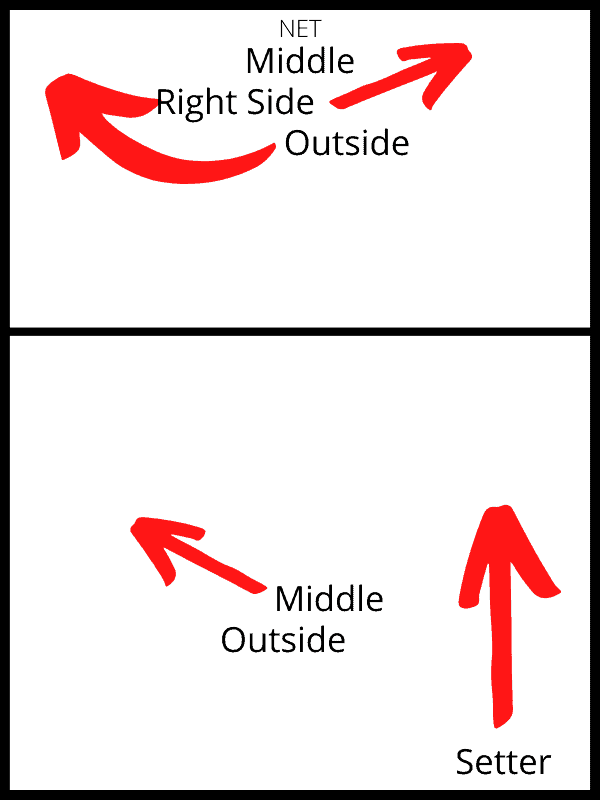
There you have it all rotations for when you are the serving team.
How To Rotate When Receiving In The 6-2 Volleyball Formation
Unfortunately the rotations are always slightly more tricky when you are the team receiving than when you are the serving team.
But hey, there is only 3 to learn so it’s not too bad.
A common lineup for a team using this formation and receiving first would be as follows:
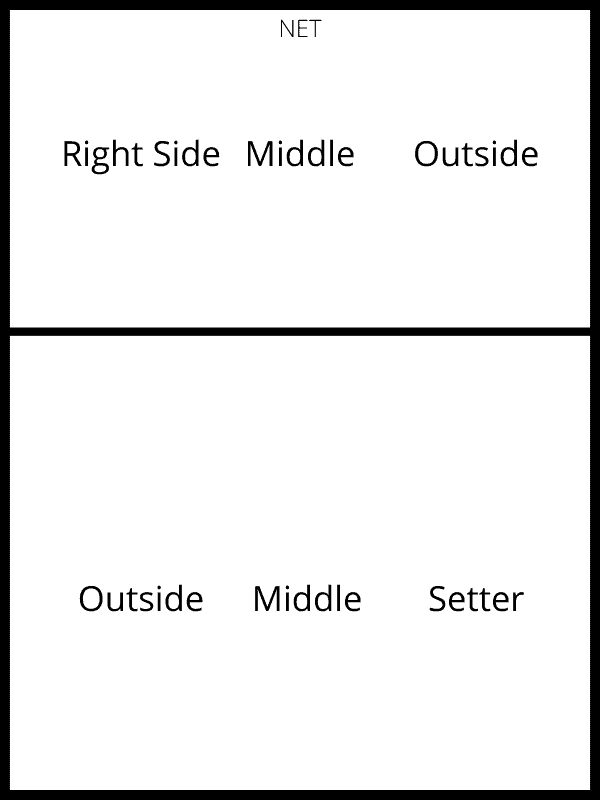
So as you can see in this formation we have the setter back court with the middle next to them and the outside player next to them.
Again I have the middle player when backcourt in position 5 and the outside in position 6.
6-2 Volleyball – Serve Receive Rotation 1
So starting out in Rotation 1, it is a bit of unique rotation as it actually has the outside player in the front row and the right sided hitter playing through opposite sides to where they normally would.
The main reason for this is because it would be really awkward for the outside hitter and swap seamlessly as they are on complete opposite sides of the court to where they would normally play.
This means for this rotation only the outside player would hit through position 2 and the right sided hitter would hit through position 4.
we obviously don’t want our setter in the pass as they need to be ready to take the second ball to set up a teammate for an attack.
The easiest way to hide the setter from the pass is to bring the outside player at position 2 back to pass in place of the setter.
The outside in the front row is affected by the setter behind them and the middle to the left of them when it comes to rotations.
The outside is perfectly fine to move back providing they don’t stand behind the setter.
To ensure the passers have a good view of the serve the right sided hitter and the middle will stack in the top left corner, the middle needs to be sure not to stand to the left of the right sided player to ensure they remain in rotation.
Once the ball has been passed up the outside who dropped back to help with the pass will move forward to position 2, the setter will have already wrapped around the outside player and will be making their way to position 2.5 (between 2 & 3) ready to set the ball.
The middle and outside players in the back row will simply swap positions and get ready to cover the block.
The right side hitter will drop back slightly in position 4 ready to hit the ball and the middle will drift into the centre again ready to hit.
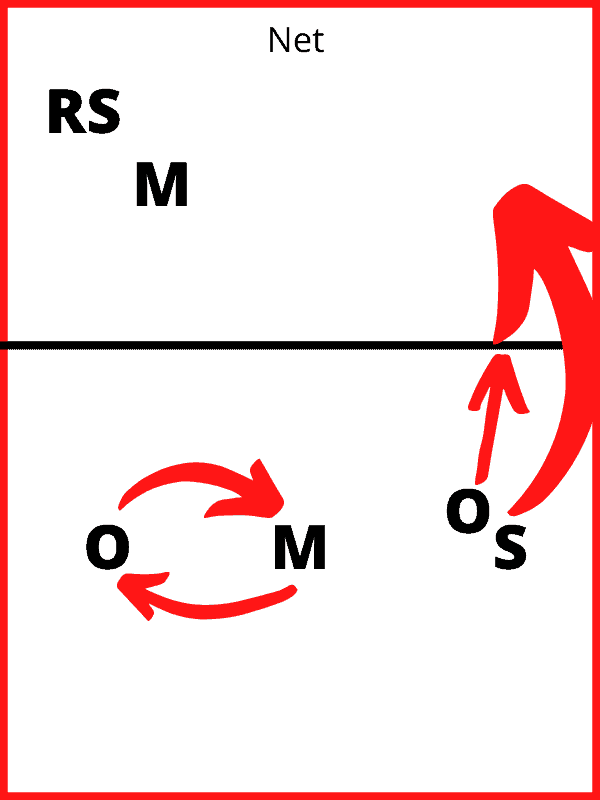
6-2 Volleyball – Serve Receive Rotation 2
Rotation 2 is actually slightly more confusing and does require some understanding of the rotation rules.
To learn more about them read here.
Briefly touching on them here the setter would now be at position 6 (Back middle), in this position they can’t cross to the left of the player at position 5 (Back left) which in this case would be the middle, they can’t cross to the right of the player at position 1 (back right) which would be the outside player, or in front of the player at position 3 (Front middle) which would be the right sided hitter.
Again we don’t want them in the pass as we want them ready to set, what we can do here is actually quite clever. By pushing the right sided hitter up tight to the net we can actually push the setter all the way forward to almost their perfect setting location.
To fill the hole where the setter has been moved we will push the middle who is at position 5 into position 6 to pass inplace of the setter. The only thing the setter needs to ensure is that stay between the middle at position 6 and the outside at position 1.
To replace the middle who has pushed over to position 6 we would get the outside who is playing front court to step back and pass at position 5. The outside moving back needs to ensure they stay in a position that is in front of the middle who is passing next to them to ensure they don’t break rotation rules.
The last player to note is the front court middle who will stack over in the top right corner to ensure they stay to the right of the right side hitter and out the way of the passers.
As the ball is passed up after the serve the outside who stepped back to help pass will move forward, the middle and outside players who are back court will both step left into their base positions and the middle player front court will drift towards the centre of the court and get ready for the set.
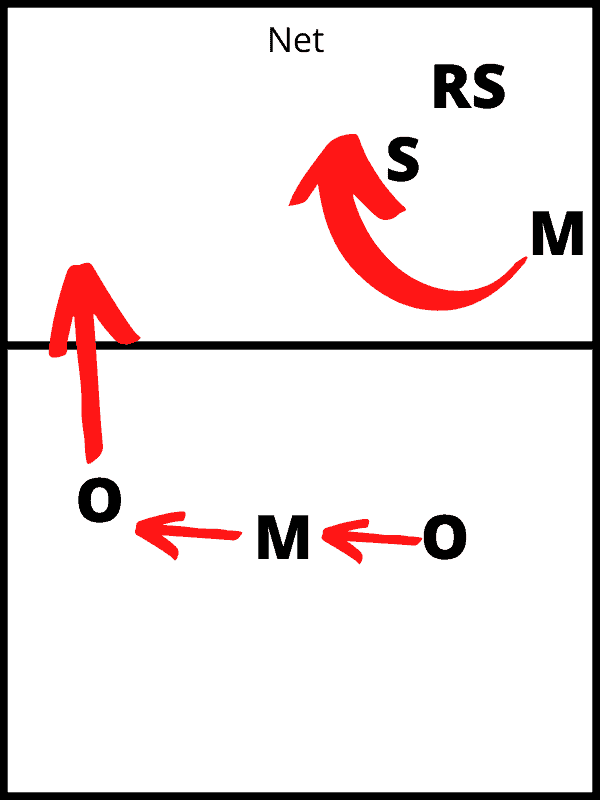
6-2 Volleyball – Serve Receive Rotation 3
This brings us to the third and final rotation.
The setter is still unfortunately still in the back court so again we need to come up with a clever way to get them out the pass.
To get the setter out of the pass we again push them forward ensuring they don’t stand in front of the middle who is ahead of them.
This one is slightly more confusing as the player we pull back to pass in place of the setter is actually still the front court outside player who in this rotation would be at position 3 (front middle).
The outside player at position 3 can not stand to the left of the middle at position 4 (front left) and they can’t stand behind the outside who they will be passing next to.
To avoid them crossing left of the middle, we actually have to push the middle into the top left corner of the court to get them out of the way of the passers view.
This leaves the passing line as the two outside players and one middle player.
Once the serve has taken place and the ball is passed up the setter will run to position 2.5 ready to set, the outside who can back to assist with the pass will step forward to position 4 ready to hit and the middle player will drift towards the centre of the court, again ready to hit.
In the back row the outside player is already standing in their base position at position 6 whilst the back court middle must run across court to position 5 ready to cover a block.
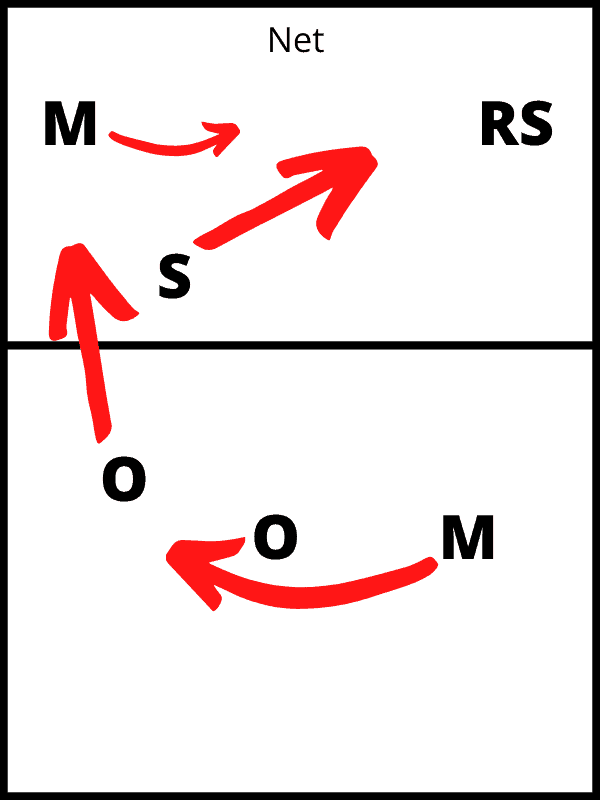
There you have it.
You have made it all rotations for the 6-2 Volleyball Formation.
Full Rotation Guide – 6-2 Volleyball Formation
Now I know what you’re thinking.
‘You just said we were done?’
And don’t worry, you are done that is all the rotations.
However, I want to ensure when you leave this article you know exactly what the 6-2 formation and exactly how and when you rotate.
With this in mind I want to go through every rotation, one of the after as if the game was happening live in front of us.
This way you can follow along and can see exactly how we move from rotation to rotation.
So prior to the game starting the referee will call in the team captains.
During this talk the referee will cover the formalities such as rules and anything specific to the venue, as part of this talk the referee will also do a coin toss to determine which team will serve and which team will receive.
The coin toss is often called by the travelling team.
Unfortunately on this occasion your captain calls wrong and the home team chooses to serve first.
This puts your team in serve receive rotation 1.

The referee blows their whistle and the opposition serve, your team gets off to a good start and wins the first point and the service.
Your team rotates one position clockwise which puts your outside hitter up to serve first for your team.

The referee blows the whistle but unfortunately the pressure must be too much for your outside as they serve out the back of the court and give the point to the opposition.
As the opposition collect the ball and rotate your team sets up in serve receive rotation 2

The referee blows the whistle but I think whatever your outside hitter had, must be contagious as the opposition serves the ball out of bounds too.
Your team rotates and now your middle player is up to serve.

The middle floats the ball over and the opposition get a good pass in and their middle hitter wins the point with a quick middle attack.
The opposition wins the point and the serve and your team sets up in serve receive rotation 3.

The opposition go for the jump serve and it is well hit, the ball is passed in well by your team and your setter goes reverse as the right side kills the ball and wins the point for your team.
Your team rotates into the final rotation as the right side hitter who just won the point for your team moves back to become the primary setter and the server.

They must be feeling good tonight as they go for the jump serve and get an ace.
This must have been the boost your team needed as you go on to win the game without dropping a single point.
Sorry I got a little carried away with the commentary there.
Hopefully now you see how these rotations work and have a great understanding of the 6-2 Volleyball Formation.
If you are more of a vizual learner and want to watch someone else explain it, check out my youtube videos below.
